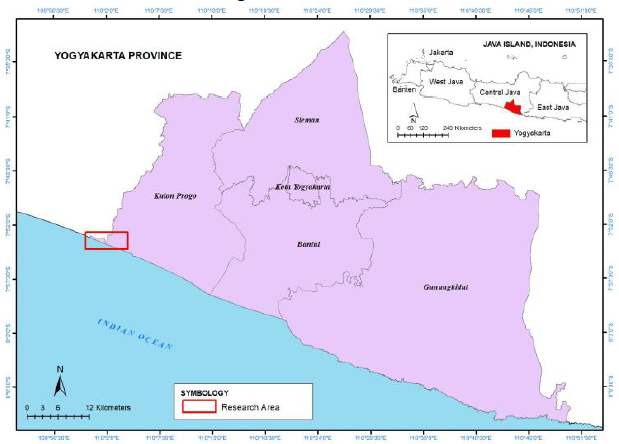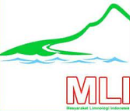Assessing Coastal Soil Capacity and Flood Risk in Kulon Progo Coastal Area, Indonesia
DOI:
https://doi.org/10.51264/inajl.v6i1.82Keywords:
Climate adaptation, Coastal soil, Flood risk, Kulon Progo, Land-use changeAbstract
The coastal areas of Kulon Progo, including the salt marshes, play a vital role in mitigating hydrometeorological disasters by regulating water flow. However, rapid land-use changes driven by the construction of Yogyakarta International Airport (YIA) have altered the region’s environmental balance. This study investigates the water retention capacity of coastal soils in Kulon Progo and examines how differences across land-use types may influence flood risks. Rather than tracking changes over time, the study uses cross-sectional comparisons and historical land-use and flood data to infer potential impacts of land transformation on hydrological hazards. Field investigations using standard soil physical property analysis were conducted at nine sites across three villages (Jangkaran, Palihan, and Glagah) in Kulon Progo to capture variations in soil characteristics related to land use changes from the airport development and its buffer zones. Bulk density ranges from 1.16 g/cm³ to 2.18 g/cm³, particle density between 2.46 g/cm³ and 5.15 g/cm³, and porosity levels from 48.16% to 66.67%. Areas near converted lands show higher density and lower porosity, reducing infiltration and increasing surface runoff. Historical flood data from the Regional Disaster Management Agency (BPBD) indicates rising flood frequency over the past decade, especially after major land conversions. This trend aligns with the study’s findings, as areas with lower porosity experience recurrent flooding. The reduced absorption capacity due to increased soil compaction is a key factor driving flood risks. This research supports Indonesia’s Nationally Determined Contributions (NDC) roadmap for climate adaptation by providing empirical evidence for disaster risk reduction. The findings highlight the need to preserve salt marshes and integrate soil management into land-use planning to enhance climate resilience and mitigate future flood risks in the Kulon Progo coastal region.
References
Amoozegar, A., Heitman, J. L., & Kranz, C. N. (2023). Comparison of soil particle density determined by a gas pycnometer using helium, nitrogen, and air. Soil Science Society of America Journal, 87(1), 1–12.
Badan Meteorologi Klimatologi dan Geofisika. (2023). Report on rainfall analysis and hydrological impacts in Yogyakarta Region. BMKG.
Badan Nasional Penanggulangan Bencana. (2022). Disaster risk assessment in Kulon Progo Regency. BNPB.
Badan Penanggulangan Bencana Daerah Kulon Progo. (2023). Flood risk map of Kulon Progo Regency. BPBD Kulon Progo.
Dinas Pekerjaan Umum Kulon Progo. (2024). Flood capacity map of Kulon Progo Regency. DPU Kulon Progo.
Ding, Q., Shao, H., Chen, X., & Zhang, C. (2022). Urban land conversion reduces soil organic carbon density under impervious surfaces. Global Biogeochemical Cycles, 36(10), e2021GB007293. https://doi.org/10.1029/2021GB007293
Fadilah, R. A., Putra, A. D., Wijayanti, F., & Nugroho, A. S. (2023). Investigation of flood pooling causes in YIA area. Teknisia, 28(1), 34–43.
Gedan, K. B., Silliman, B. R., & Bertness, M. D. (2009). Centuries of human-driven change in salt marsh ecosystems. Annual Review of Marine Science, 1(1), 117–141. https://doi.org/10.1146/annurev.marine.010908.163930
Hoorman, J. J., Sá, J. M., & Reeder, R. (2011). The biology of soil compaction. Science, 68, 49–57.
Huang, B., Yuan, Z., Li, D., Zheng, M., Nie, X., & Liao, Y. (2020). Effects of soil particle size on the adsorption, distribution, and migration behaviors of heavy metal(loid)s in soil: A review. Environmental Science: Processes & Impacts, 22(8), 1596–1615. https://doi.org/10.1039/D0EM00126H
Kementerian Lingkungan Hidup dan Kehutanan. (2020). Peta jalan implementasi nationally determined contribution (NDC): Adaptasi. KLHK.
Kementerian Lingkungan Hidup dan Kehutanan. (2022). Enhanced nationally determined contribution (NDC) of Indonesia. KLHK.
Khaerudin, D. N., Suharyanto, A., & Harisuseno, D. (2017). Infiltration rate for rainfall and runoff process with bulk density soil and slope variation in laboratory experiment. Nature Environment & Pollution Technology, 16(1), 1–8.
Lal, R. (2020). Soil organic matter and water retention. Agronomy Journal, 112(5), 3265–3277. https://doi.org/10.1002/agj2.20282
Mustofa, I., Ramdlan, M. S., & Suharyanto, H. H. R. (2025). The potency of salt marshes for enhancing climate change adaptation and mitigation: Case study Kulon Progo, Yogyakarta, Indonesia. IOP Conference Series: Earth and Environmental Science, 1438(1), 012053. https://doi.org/10.1088/1755-1315/1438/1/012053
Mustofa, I., Wacano, D., Setyawan, B. D., Faradis, I., Nabil, H., Al Khaidar, M., & van Minnen, T. (2025). Blue carbon potential of salt marshes in Kulon Progo for climate change mitigation in Indonesia. Asian Journal of Innovation and Entrepreneurship, 10(1), 45–59.
Ndaru, S. A. (2025). Drainage system analysis at YIA Airport and its impact on flooding. Journal of Civil Engineering, 14(2), 88–97.
Ning, Y. (2024). Mendeteksi perubahan penggunaan lahan secara spasial dan temporal di Bandara Internasional Yogyakarta pada citra Google Earth. Jurnal Geografi, 13(1), 15–27.
Ningsih, R. L., & Mutaqin, B. W. (2024). Multi-hazard assessment under climate change in the aerotropolis coastal city of Kulon Progo, Yogyakarta–Indonesia. Journal of Coastal Conservation, 28(1), 5. https://doi.org/10.1007/s11852-023-00966-6
Nurhidayah, L., Davies, P., Alam, S., Saintilan, N., & Triyanti, A. (2022). Responding to sea level rise: Challenges and opportunities to govern coastal adaptation strategies in Indonesia. Maritime Studies, 21(3), 339–352. https://doi.org/10.1007/s40152-022-00279-w
Partarini, N. M., & Wirastri, M. V. (2024). Community-based flood resilience: Mitigation efforts in semi-urban areas using nature-based solutions. Atma Inovasia Journal, 4(2), 145–157.
Prasena, A., & Shrestha, D. P. (2013). Assessing the effects of land use change on runoff in Bedog sub watershed Yogyakarta. The Indonesian Journal of Geography, 45(1), 48–59. https://doi.org/10.22146/ijg.2387
Puspa, F. W., & Purwono, N. A. S. (2020). Analysis of Serang River mouth conditions and its impact on flood risk. Prosiding Seminar Nasional Teknik Sipil, 6, 215–222.
Ramadhani, A., Devi, L., Sihombing, D., & Raphonita, C. (2022). Future disaster risk reduction strategy based on land use prediction in a surrounding area of a newly developed airport infrastructure. Advances in Science and Technology, 112, 65–74. https://doi.org/10.4028/www.scientific.net/AST.112.65
Rühlmann, J., Körschens, M., & Graefe, J. (2006). A new approach to calculate the particle density of soils considering properties of the soil organic matter and the mineral matrix. Geoderma, 130(3–4), 272–283. https://doi.org/10.1016/j.geoderma.2005.02.002
Saco, P. M., McDonough, K. R., Rodriguez, J. F., Rivera-Zayas, J., & Sandi, S. G. (2021). The role of soils in the regulation of hazards and extreme events. Philosophical Transactions of the Royal Society B: Biological Sciences, 376(1834), 20200178. https://doi.org/10.1098/rstb.2020.0178
Smith, P., House, J. I., Bustamante, M., Sobocká, J., Harper, R., Pan, G., & Pugh, T. A. (2016). Global change pressures on soils from land use and management. Global Change Biology, 22(3), 1008–1028. https://doi.org/10.1111/gcb.13068
Spurgeon, D. J., Keith, A. M., Schmidt, O., Lammertsma, D. R., & Faber, J. H. (2013). Land-use and land-management change: Relationships with earthworm and fungi communities and soil structural properties. BMC Ecology, 13(46), 1–13. https://doi.org/10.1186/1472-6785-13-46
Sugianto, S., Deli, A., Miswar, E., Rusdi, M., & Irham, M. (2022). The effect of land use and land cover changes on flood occurrence in Teunom Watershed, Aceh Jaya. Land, 11(8), 1271. https://doi.org/10.3390/land11081271
Utami, W., Sugiyanto, C., & Rahardjo, N. (2024). Estimated changes in carbon stock due to changes in land use around Yogyakarta International Airport. Journal of Degraded and Mining Lands Management, 11(3), 5727–5740. https://doi.org/10.15243/jdmlm.2024.113.5727
Wulandani, N. A., Wibowo, Y. A., & Nurwijayanti, A. (2024). Identification of coastal typology and utilization of geospatial technology for tsunami hazard modeling in Kulon Progo coastal area, Special Region of Yogyakarta, Indonesia. IOP Conference Series: Earth and Environmental Science, 1357(1), 012040. https://doi.org/10.1088/1755-1315/1357/1/012040

Downloads
Published
Issue
Section
License
Copyright (c) 2025 Ikrom Mustofa, Niesa Hanum Mistoro, M. Said Ramdlan, Dewi Wulandari

This work is licensed under a Creative Commons Attribution 4.0 International License.






